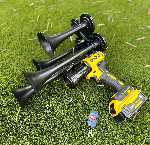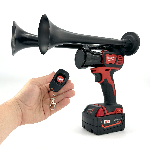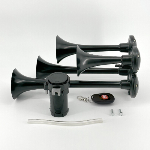An air horn produces a high-decibel sound by releasing compressed air through a vibrating diaphragm, creating a loud and powerful noise that can be heard from a significant distance. Air horns have been used for decades in various industries and settings, from alerting ships of impending danger to signaling the beginning of a race. In recent years, however, the use of air horns in non-emergency situations has become a source of noise pollution and annoyance for many people.
The widespread availability and affordability of air horns have led to their misuse in public spaces, where their deafening sound can disrupt daily activities and cause distress to those nearby. Studies have shown that prolonged exposure to loud noise, such as that produced by air horns, can lead to hearing damage and various health issues. It is crucial for individuals and communities to be aware of the potential harm caused by excessive noise and to take measures to mitigate its impact.
One solution to the problem of excessive noise pollution from air horns is the implementation of regulations and guidelines governing their use in public spaces. By setting limits on when and where air horns can be used, authorities can help minimize the disruption caused by these devices and protect the well-being of residents. Additionally, raising awareness about the negative effects of noise pollution and promoting quieter alternatives can encourage individuals to consider the impact of their actions on others.
What is the purpose of a loud air horn noise and how does it affect our environment?
The loud air horn noise is typically produced by a compressed air system and is commonly used in emergency situations or to alert individuals of potential dangers. The purpose of a loud air horn noise is to quickly grab the attention of people in the vicinity and signal the need for action or caution. While the noise can be effective in certain situations, it can also have negative impacts on the environment, such as causing noise pollution and disrupting wildlife. In the following section, we will explore the different uses of loud air horn noises and discuss how they can be both beneficial and harmful.
**Effects on Hearing**
Exposure to loud noises, such as air horn blasts, can have a significant impact on your hearing health. Prolonged or repeated exposure to high noise levels can result in noise-induced hearing loss. This type of hearing loss is usually gradual and painless but can be permanent. The loud sound waves from air horns can damage the delicate hair cells in the inner ear, leading to hearing loss over time.
**Disturbance to Surroundings**
Loud air horn noise can be a major source of disturbance to the surrounding environment. In residential areas, loud air horn blasts can disrupt the peace and quiet, causing annoyance and irritation to residents. In urban areas, the sudden and loud noise from air horns can startle pedestrians and drivers, leading to potential safety hazards on the road.
**Regulations and Restrictions**
To address the negative impact of loud air horn noise, many cities and regions have implemented regulations and restrictions around the use of air horns. These regulations may include limits on the sound levels produced by air horns, restrictions on when and where they can be used, and penalties for violating noise ordinances. By enforcing these regulations, authorities aim to reduce noise pollution and protect the well-being of residents.
**Noise Pollution Statistics**
According to the World Health Organization, noise pollution is a growing concern that affects millions of people worldwide. In urban areas, environmental noise levels are often above recommended levels, leading to various health issues. In the United States, the Environmental Protection Agency estimates that approximately 100 million people are exposed to noise levels that are harmful to their health. It is crucial to address sources of noise pollution, such as loud air horn noise, to protect public health and well-being.
https://youtube.com/watch?v=5Ne7u6sox7M
What are some common sources of disruptive noise in public spaces?
Disruptive noise in public spaces can arise from a variety of sources, such as loud music, construction work, vehicle alarms, and outdoor events. These sources of noise can often lead to disturbances for individuals in the vicinity, affecting their peace and quiet.
The three most important pieces of information are:
- Disruptive noise in public spaces can come from various sources
- The noise can cause disturbances and impact the peace of individuals
- Identifying these sources is essential in addressing the issue
How can disruptive noise in public spaces be effectively managed?
To effectively manage disruptive noise in public spaces, it is crucial to implement soundproofing measures, establish noise ordinances, and raise awareness about the impact of noise pollution. By taking proactive steps to address the issue, communities can promote a more peaceful and comfortable environment for residents and visitors.
The three most important pieces of information are:
- Implement soundproofing measures to reduce noise levels
- Establish noise ordinances to regulate noise levels in public spaces
- Raise awareness about the negative impact of noise pollution
What are the potential health effects of prolonged exposure to loud noise?
Prolonged exposure to loud noise can have detrimental effects on an individual's health, including hearing loss, increased stress levels, and sleep disturbances. It is important to take preventive measures to protect oneself from excessive noise exposure and prioritize one's well-being.
The three most important pieces of information are:
- Prolonged exposure to loud noise can result in hearing loss
- Increased stress levels and sleep disturbances can be caused by loud noise
- Preventive measures should be taken to protect oneself from excessive noise exposure
How can individuals protect themselves from the negative effects of loud noise?
Individuals can protect themselves from the negative effects of loud noise by using ear protection devices, maintaining a safe distance from loud noise sources, and seeking quiet environments when possible. By taking proactive steps to reduce exposure to loud noise, individuals can safeguard their hearing and overall well-being.
The three most important pieces of information are:
- Use ear protection devices to reduce the impact of loud noise
- Maintain a safe distance from loud noise sources to minimize exposure
- Seek quiet environments to protect one's hearing and well-being
What role can community members play in addressing noise pollution?
Community members play a vital role in addressing noise pollution by reporting noise disturbances to local authorities, advocating for noise reduction initiatives, and promoting awareness about the importance of maintaining a peaceful environment. By working together, communities can create a more harmonious and tranquil living environment for everyone.
The three most important pieces of information are:
- Report noise disturbances to local authorities for action
- Advocate for noise reduction initiatives in the community
- Promote awareness about the significance of maintaining a peaceful environment
Conclusion
In conclusion, loud air horn noise can be a disruptive and annoying sound that is often used for safety purposes in various settings such as sporting events, construction sites, and emergency situations. It is important to be mindful of the potential impact of loud noises on our hearing and overall well-being. Proper precautions should be taken to mitigate the effects of loud air horn noise on both individuals and communities.











 https://bosshorn.com
https://bosshorn.com

























































